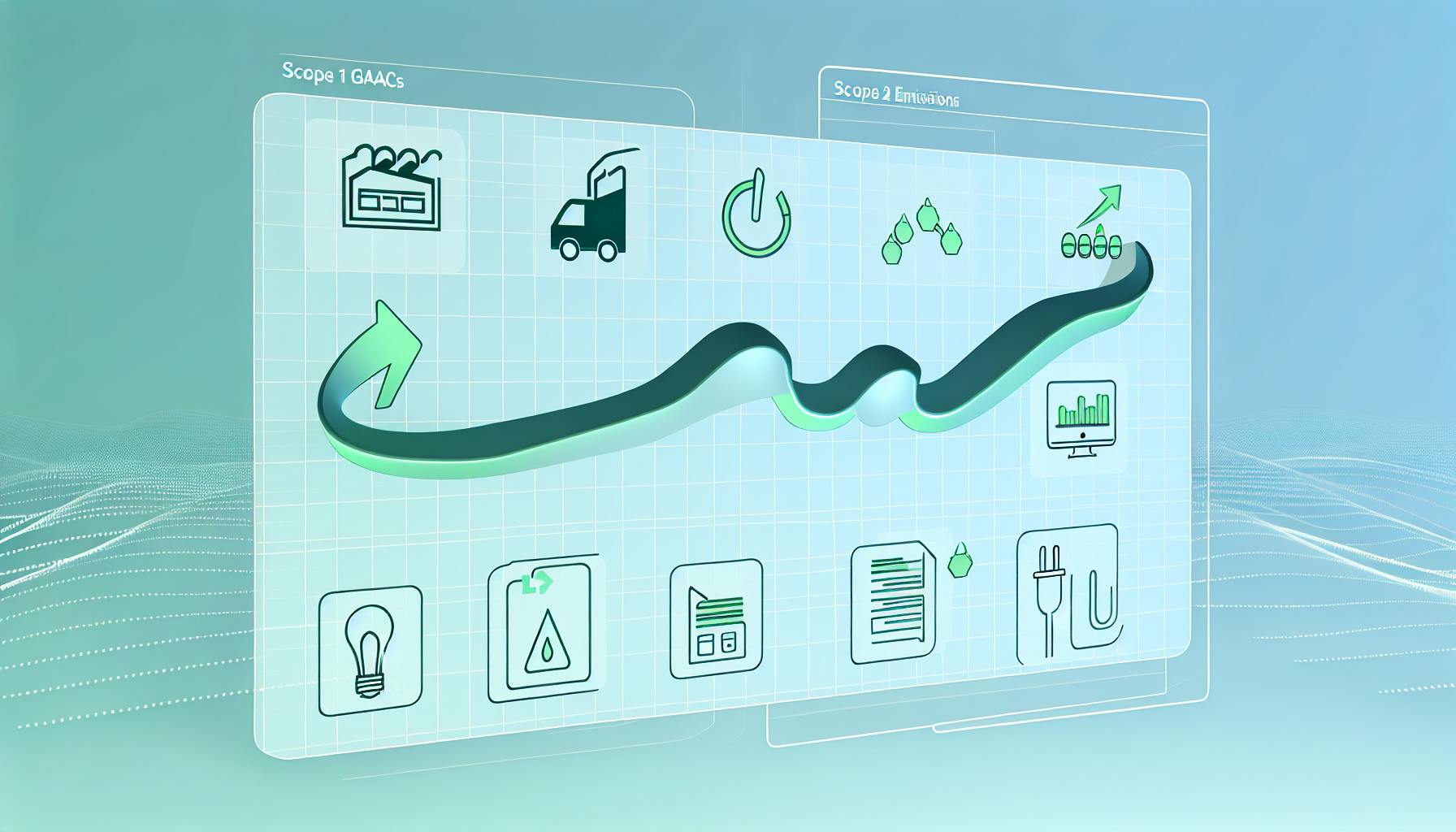Measuring a company's carbon footprint can seem daunting, but it's an essential first step for any business aiming to reduce their climate impact.
This comprehensive guide will walk you through the entire process of calculating your company's carbon footprint using industry-standard methodologies and tools.
You'll learn the step-by-step approach to identify all sources of emissions, select the right carbon accounting tools, set organisation boundaries, apply GHG protocol principles, create an emissions inventory, set reduction targets, and generate a transparent carbon footprint report to engage stakeholders.
Introduction to Carbon Footprint Measurement
Measuring a company's carbon footprint is an important first step towards understanding and reducing its climate impact. By quantifying greenhouse gas (GHG) emissions, businesses can track progress over time, identify opportunities to cut emissions and costs, comply with regulations, and satisfy stakeholders.
This guide will provide small and medium enterprises (SMEs) with a step-by-step process for accurately measuring their carbon footprint using internationally recognised GHG accounting methods and principles.
Understanding the Company Carbon Footprint
A company's carbon footprint refers to the total amount of GHGs emitted directly or indirectly from its operations and activities. This includes emissions from:
- Energy use - heating, cooling, lighting, IT systems, machinery, etc.
- Transportation - business travel, logistics, commuting, fleet vehicles
- Purchased materials - raw materials, packaging, office supplies
- Waste - landfill waste, wastewater
To get a complete picture, a company's carbon footprint measures all three greenhouse gas protocol scopes:
- Scope 1 - Direct emissions from owned/controlled sources like vehicles and equipment
- Scope 2 - Indirect emissions from purchased electricity and heating
- Scope 3 - Other indirect emissions from business travel, procurement, waste disposal etc.
The Importance of Measuring Carbon Footprint for Businesses
Here are some of the key reasons SMEs should measure their carbon footprint:
- Track performance over time and demonstrate progress towards climate goals
- Identify "hot spots" to target for emissions reductions
- Comply with emerging disclosure regulations and standards
- Meet sustainability reporting demands of investors and shareholders
- Satisfy customers and stakeholders by improving sustainability performance
- Uncover operational inefficiencies and cost savings opportunities
Outline of the Carbon Footprint Measurement Guide
This guide will cover:
- Determining organisational and operational boundaries
- Choosing the right carbon accounting methodology
- Collecting accurate activity data
- Calculating emissions using verified tools
- Best practices for data management and reporting
Follow along as we walk through each step required for SMEs to measure their company's carbon footprint.
How do businesses measure their carbon footprint?
Collecting accurate emissions data is crucial for measuring your company's carbon footprint. Here are the key steps:
Gather Data on Emission Sources
Make a list of all potential sources of greenhouse gas emissions from your operations. This includes:
- Direct emissions from owned or controlled equipment and vehicles (Scope 1 emissions)
- Indirect emissions from purchased electricity and heating (Scope 2)
- Other indirect emissions from business travel, waste disposal, etc (Scope 3)
Collect Activity Data
For each emission source, collect data on the activities that cause emissions. For example:
- Energy use data (electricity, gas, fuel, etc) in kWh or liters
- Business travel data (flights, hotel nights, miles driven)
- Waste disposal quantities
Calculate Emissions
Use emission factors to convert activity data into metric tons of CO2 equivalent emissions. Free carbon calculators for business like the EPA Center for Corporate Climate Leadership GHG Emission Calculator can help with calculations.
Track and Report Over Time
Track emissions data over time to identify trends and opportunities for reduction. Report to stakeholders annually as part of sustainability reporting.
Using spreadsheets to collect data and carbon accounting software can simplify the process and ensure consistency. Engaging stakeholders across the company is also key for obtaining accurate data. With the right systems in place, measuring emissions can be straightforward even for small businesses targeting how to measure carbon footprint of a company.
How is carbon footprint measured?
A company's carbon footprint is measured by calculating the total greenhouse gas (GHG) emissions from all direct and indirect activities across its value chain. This includes emissions from:
- Direct operations - Such as fuel burned on-site, company vehicles, fugitive emissions. These make up Scope 1 emissions.
- Purchased electricity - Emissions created during the production of electricity purchased and consumed by the company. This makes up Scope 2 emissions.
- Supply chain - Emissions from extracting raw materials, manufacturing products, and transportation. These make up Scope 3 emissions.
To measure the carbon footprint, data is collected on the company's energy usage, materials, waste, transportation, etc. This data is then input into carbon accounting software or calculators that quantify emissions using established greenhouse gas conversion metrics and protocols.
The key steps are:
- Determine organisational and operational boundaries
- Identify all emission sources
- Collect activity data
- Calculate emissions using appropriate calculations and emission factors
- Report and validate results
Standard methodologies like the Greenhouse Gas Protocol provide detailed guidance on calculation methods, emissions factors to use, and reporting principles. Getting accurate carbon footprint measurement requires systematic data collection and calculations across all scopes of emissions. Automated software can simplify this complex accounting process for companies.
How do companies track their carbon footprint?
The first step in measuring your company's carbon footprint is to conduct a carbon audit. This involves analysing your business operations to identify the sources of greenhouse gas (GHG) emissions.
Here are the key steps to measure your company's carbon footprint:
Gather Data on Emission Sources
- Energy usage - electricity, fuel, heat, steam used in your buildings and vehicles
- Business travel - flights, rental cars, employee commuting
- Waste - amount sent to landfills
- Purchased materials - emissions from manufacturing and transporting goods you buy
Calculate Emissions Using Available Tools
Many free online carbon calculators exist to help SMEs determine emissions. For example, the GHG Protocol offers industry-specific tools covering Scope 1, 2, and 3 emissions.
You can also use spreadsheet tools like the Carbon Footprint Calculator for SMEs.
Analyse Results to Find Hotspots
The audit results will show your company's total annual CO2 emissions and highlight the biggest contributors.
Common hotspots are electricity use, corporate travel, shipping and logistics. Focus reduction efforts here for maximum impact.
Offset Unavoidable Emissions
Consider carbon offsets to mitigate the emissions you cannot eliminate yet. These fund projects like reforestation that remove CO2 from the atmosphere.
Report & Communicate
Share sustainability reports with stakeholders demonstrating your commitment to emissions reductions over time. Highlight achievements and future goals.
Following these steps will help your company accurately measure and track its carbon footprint. Consistent monitoring allows you to set reduction targets and make informed decisions to reach net zero emissions.
What is the formula for calculating carbon footprint?
The basic formula for calculating a company's carbon footprint is:
Carbon Footprint = Activity Data x Emission Factor
Where:
- Activity Data refers to a quantifiable measure of operations that have associated emissions, such as:
- kWh of electricity used
- Gallons of fuel burned
- Tonnes of waste generated
- Emission Factor is the amount of emissions released per unit of activity data. Common emissions factors may include:
- CO2 emitted per kWh of electricity
- CO2 emitted per gallon of gasoline burned
Emission factors are often available from government databases or industry associations. For example, the US Environmental Protection Agency provides the following emission factors:
- Gasoline: 8,887 grams CO2 per gallon burned
- Diesel: 10,180 grams CO2 per gallon burned
So for every gallon of gasoline a company burns, they release 8,887 grams or 0.008887 metric tons of CO2 into the atmosphere.
By multiplying these emission factors by the relevant activity data (e.g. 5,000 gallons of gasoline), we can estimate the company's carbon footprint from each activity. Summing the carbon footprints for all activities provides the total company carbon footprint.
This formula can be applied to all direct and indirect emissions sources across a company's operations and supply chain. Using accurate activity data and emissions factors is key to measuring carbon footprint correctly.
sbb-itb-919600f
Identifying Emission Sources for Small Business Carbon Footprint
This section outlines key areas to collect emissions data across company operations and supply chain.
Direct Emissions from Company-Owned Resources
Gather data on fuel, electricity, fleet vehicles and other sources under a company's ownership and control. This includes:
- Fuel combustion from boilers, furnaces, vehicles, generators, etc.
- Fugitive emissions from refrigeration, air conditioning, etc.
- Process emissions from chemical production, manufacturing, etc.
Collect fuel purchase records and meter readings to calculate emissions.
Indirect Emissions from Purchased Energy
Collect supplier data on emissions associated with purchased electricity, steam, heating and cooling. This includes:
- Purchased electricity used onsite
- Purchased heating, cooling, and steam used onsite
Obtain usage data and emission factors from energy suppliers.
Quantifying Other Indirect Emissions
Quantify emissions from business travel, transportation, waste, materials, and other indirect sources. This includes:
- Air travel and ground transportation
- Third party logistics and distribution
- Waste disposal
- Extracted/produced materials and fuels
- Contracted services like IT infrastructure
Gather activity data and emission factors for each category based on industry standards. Prioritize the largest contributors.
To accurately measure company emissions, develop an emissions inventory following the GHG Protocol methodology. Use a carbon accounting software to collect data and calculate footprint across all scopes automatically. Benchmark against industry averages and identify hotspots to focus reduction efforts.
Utilising Tools for Calculating Company Carbon Footprint
There are several options available for companies to calculate their carbon footprint, ranging from simple online calculators to more advanced life cycle assessments (LCA). The best approach depends on the size and complexity of the business.
Free Carbon Footprint Calculator for Business
Basic online carbon calculators provide a quick and easy way for small companies to estimate their greenhouse gas (GHG) emissions. They typically require users to input data on energy usage, transportation, waste, etc. and then convert this into metric tons of carbon dioxide equivalent (tCO2e) emitted.
For example, the EPA Center for Corporate Climate Leadership GHG Emission Calculator allows companies to select their industry sector and enter emissions data across scopes 1, 2 and 3. It generates an estimate of total annual emissions that serves as a reasonable starting point.
While simple calculators have limitations in accuracy, they enable SMEs to gauge their carbon footprint with minimal effort. This can highlight priority areas to address in working towards emissions reductions.
Adopting GHG Protocol's Robust Calculation Tools
For more rigorous carbon accounting, the GHG Protocol provides standardized Excel-based calculation tools aligned with international accounting principles.
The Corporate Accounting and Reporting Standard spreadsheet facilitates comprehensive tracking of scope 1, 2 and 3 emissions at the company level. It incorporates activity data such as fuel and electricity usage into emission factor formulas tailored to various locales and industries.
By following the structure of this robust tool, SMEs can produce detailed carbon inventories and identify hotspots across operations and supply chains. This enables data-driven strategies to curb emissions through operational improvements, supplier engagement, and other initiatives.
Employing LCA Software for Comprehensive Footprints
To calculate emissions at the product level, Life Cycle Assessments (LCA) analyse GHG impacts across the full value chain from raw material extraction through to end-of-life disposal.
For example, SimaPro and OpenLCA integrate extensive databases of emission factors. By modelling product systems, companies can pinpoint carbon hotspots in materials, manufacturing, distribution and other lifecycle stages.
While intensive in data requirements, LCA footprinting and modelling facilitates targeted reductions through product redesigns, material substitutions, lean manufacturing, etc. For SMEs offering physical goods, this method provides deep supply chain visibility and opportunities to lower both organisational and value chain emissions.
Setting Boundaries and Selecting Methodologies for Accurate Measurement
Accurately measuring a company's carbon footprint begins with clearly defining organisational and operational boundaries. This involves determining which business units, facilities, and activities will be included in the analysis.
Defining Organisational Boundaries for Carbon Accounting
The first step is deciding the organisational boundaries. This refers to which operations, subsidiaries, or facilities will have their emissions included in the carbon footprint measurement. Some key considerations include:
- Whether to include emissions from partially or fully owned subsidiaries and joint ventures
- If emissions from contracted operations should be included
- If historical emissions will be accounted for from acquisitions or divestitures
Clearly outlining the organisational boundaries ensures consistency across reporting periods and enables accurate year-over-year comparisons.
Determining Operational Boundaries Within the Company
After defining organisational boundaries, companies must determine operational boundaries. This refers to which activities and emissions sources will be included within the chosen organisational boundaries. Companies should account for:
- Direct emissions from owned or controlled sources like vehicles, equipment, and manufacturing
- Indirect emissions from purchased electricity and heat
- Other indirect emissions like business travel, waste disposal, etc.
Determining boundaries requires balancing accuracy with practicality regarding data availability. Companies may phase in more data sources over time.
Applying GHG Protocol Accounting and Reporting Principles
Companies should adhere to the principles of the GHG Protocol to ensure accurate, consistent emissions calculations, including:
- Relevance: Ensure the carbon footprint appropriately reflects the company's emissions and serves decision-making needs
- Completeness: Account for all emission sources within the defined inventory boundary
- Consistency: Use consistent methodologies and emissions factors across each reporting period
- Transparency: Address all relevant issues in a factual and coherent manner
Additionally, emissions factors used to convert activity data into CO2 equivalents should suit the company's region and industry. Various free carbon calculators for business build in appropriate emissions factors.
Following GHG Protocol principles tailored to the company's operations enables accurate carbon accounting and reporting across the organisation.
Creating a Company Carbon Footprint Report
Using footprint measurement as a baseline, companies can track performance over time, plan reductions, and engage stakeholders through reporting.
Developing an Emissions Inventory for Reporting
To create a detailed emissions inventory for carbon footprint reporting, companies should follow these key steps:
- Collect activity data on energy usage, materials, waste, transportation, etc. This provides the foundation for calculations.
- Apply emissions factors to the activity data to convert to metric tons CO2 equivalent (tCO2e). Factors may come from industry standards or be based on product/fuel types.
- Categorise emissions into scopes - Scope 1 for direct emissions, Scope 2 for indirect emissions from purchased energy, and Scope 3 for other indirect emissions across the value chain.
- Document methodology and assumptions used to provide transparency on inventory calculations.
- Compile the inventory with totals by scope, source, location, etc. This catalogue of emissions serves as the baseline carbon footprint.
Regularly updating the inventory with current activity data allows tracking performance over time.
Setting Targets for Carbon Footprint Reduction
Companies can utilise their carbon footprint analysis to establish emissions reduction targets, for example:
- 30% decrease in total tCO2e by 2030 from a 2019 base year
- 100% renewable electricity by 2025
When setting targets, consider:
- Ambition level - Is the target aligned to climate science and the organisation's net zero goals?
- Scope coverage - Which scopes are included? A robust target would cover Scopes 1, 2 & material Scope 3 emissions.
- Baseline year - What is the starting point for measuring progress?
- Target year - When does the company aim to achieve the target? Common timeframes are 2030 and 2050.
Companies then implement decarbonisation strategies across operations, supply chain, etc. to work toward the emissions reduction targets.
Enhancing Engagement through Carbon Footprint Reporting
Companies can provide value to both internal and external stakeholders by reporting emissions inventory, progress and targets through mediums like:
- Sustainability reports - for investors/customers
- Internal newsletters - for employees
- Product labeling - for consumers
This reporting demonstrates the seriousness and strategic nature of the company's commitment to environmental sustainability.
Carbon Footprint Report Example for Stakeholder Transparency
Below is an excerpt illustrating what a company's annual sustainability report section on carbon footprint tracking and performance may contain:
Carbon Emissions Performance
In 2021, we achieved a 28% reduction in total tCO2e from our 2019 baseline. This keeps us on track to meet our science-based target of 50% reduction by 2030. Our 2021 emissions inventory categorised by scope is summarised in the table below:
Scope
2021 tCO2e
% Change from 2019
Scope 1
35,000
-22%
Scope 2
12,500
-35%
Scope 3
102,000
-30%
Total
149,500
-28%
Key drivers of our emissions reductions have been our switch to 100% renewable electricity in 2020 and supplier engagement initiatives to reduce embodied carbon in materials. We still have work to do but are committed to transparency and achieving net-zero by 2050.
This example outlines clear metrics on progress towards targets, details key reduction initiatives, and demonstrates a commitment to stakeholders. Companies should customise carbon reporting based on their own footprinting analysis, strategies and audience.
Conclusion: Summarising the Carbon Footprint Measurement Journey
Accurately measuring a company's carbon footprint is an essential step towards managing climate impacts. This guide outlined key steps SMEs can take to quantify and reduce their footprint.
Recap of Essential Steps in Carbon Footprint Measurement
The most vital aspects of carbon footprint measurement for SMEs include:
- Data collection - Gather data on energy usage, transportation, waste, etc. This forms the foundation for calculation.
- Calculation tools - Use specialised tools like EcoHedge software to analyse data and model emissions.
- Boundary setting - Determine which parts of the company's operations to include. Set realistic limits.
- Reporting - Document the footprint analysis with details on methodology, scope, and findings.
Future Directions After Establishing a Carbon Footprint Baseline
Once a footprint baseline is established, companies can:
- Create reduction plans - With insights from footprint analysis, set targets to lower future emissions.
- Continue performance tracking - Monitor footprint over time to assess progress on goals.
- Engage stakeholders - Share sustainability reports with investors, customers, employees to showcase progress.
Accurate carbon accounting is the first step to managing climate impacts. By following the guidelines here and leveraging solutions like EcoHedge, SMEs can effectively understand and reduce their footprint.



